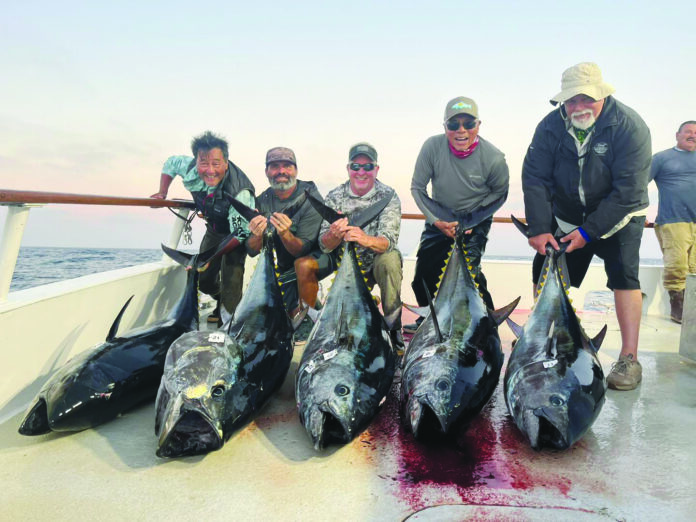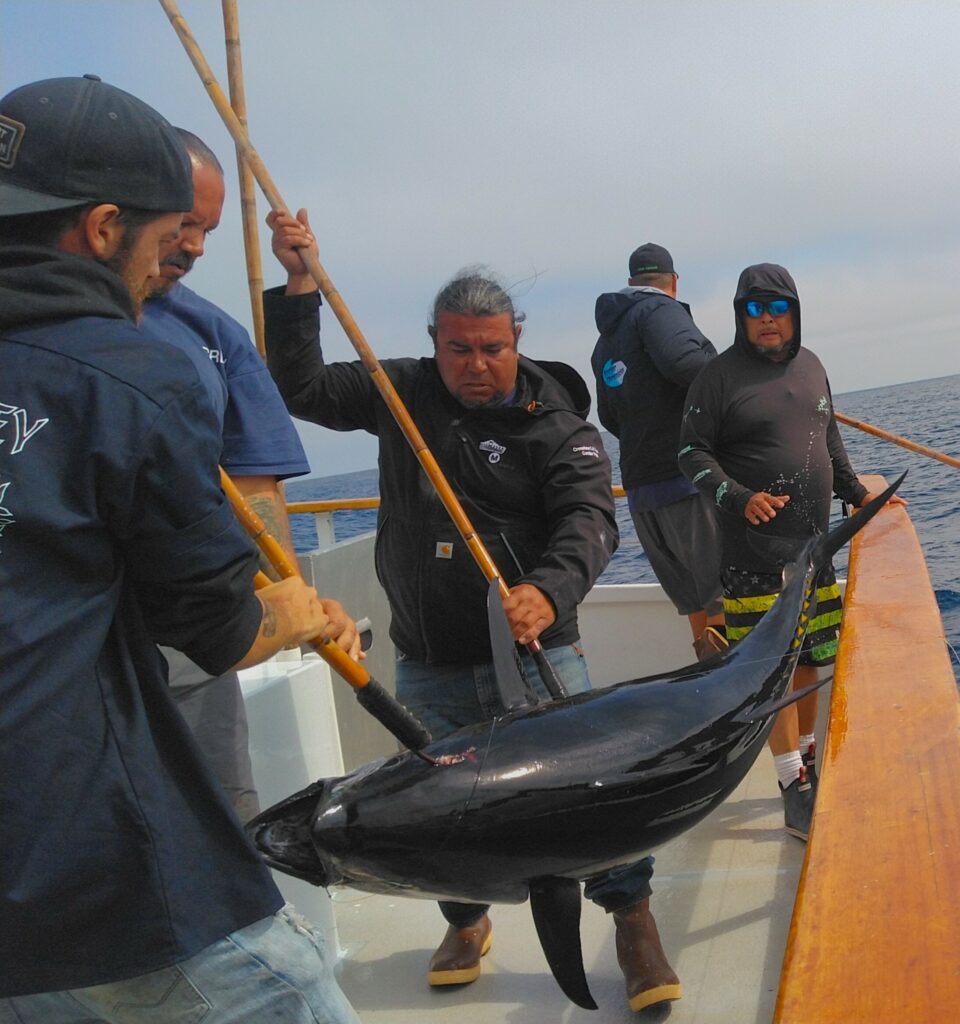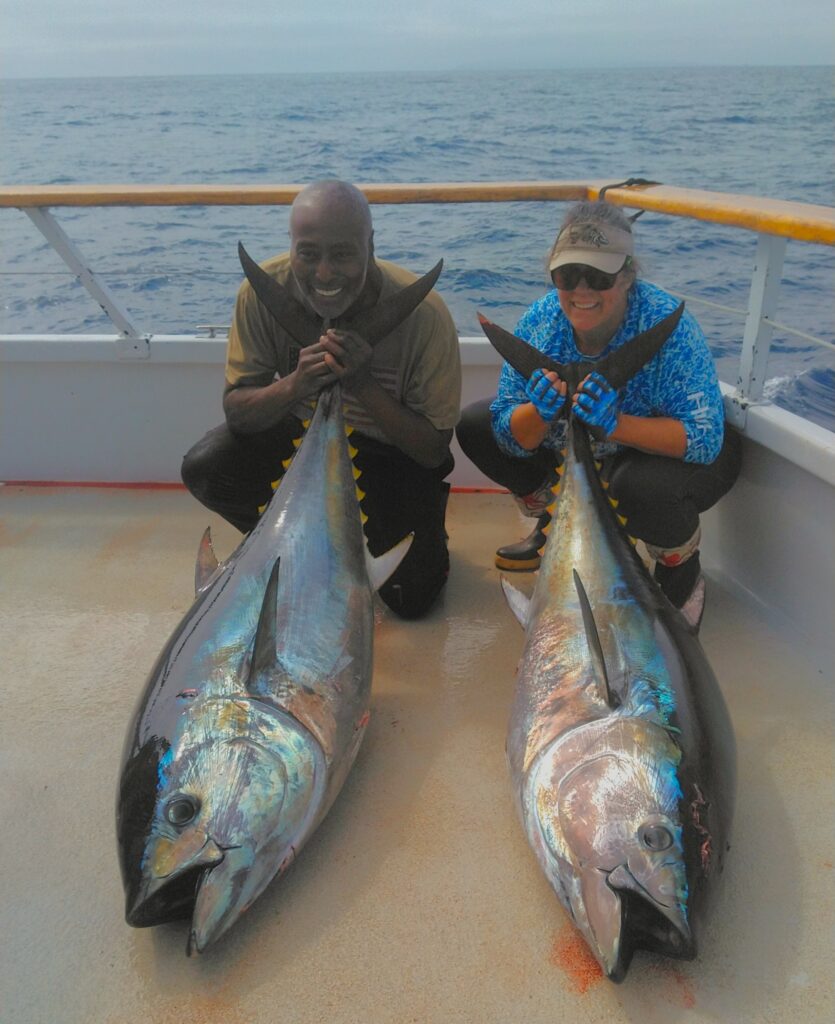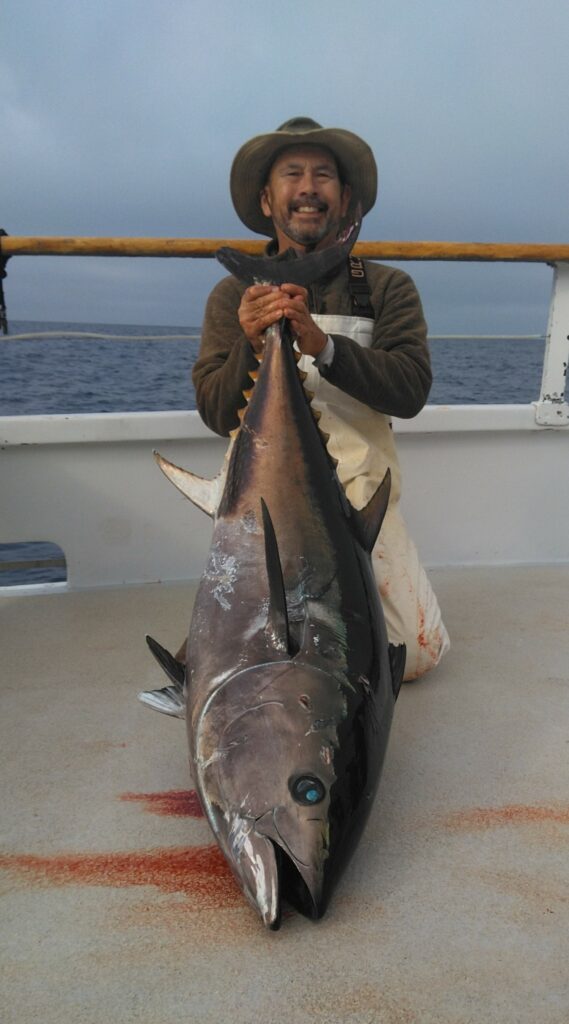
BY MERIT McCREA
SAN DIEGO/OCEANSIDE — The offshore fleet faced tricky choices between a kelp yellowtail bite to the south that got going only to die and then rebound, and running northwest for an area loaded with bluefin but the biters being mostly 100-pound-plus models.
The big guns required to land such fish meant getting these fish to bite heavy line. That meant the kite, the sinker rig or night fishing iron.
However, there were a few fished hooked on the fly-line as well, some on heavy tackle too.
It’s taking at least 60-pound tackle, with 80- or 100- recommended. Finding fish to stop on wasn’t hard, but getting them to bite that heavy line was.
Looking at the daily fish counts was deceiving. The numbers made it look like fish were hard to find. But the reality was they were just too darned big to land a lot of.
The exceptions came for those able to fish the nighttime hours and connect with biters. While the word on the iron in recent weeks was centered up on the smaller 200- to 300-gram models, the recent word was the long knives were again in the running as well.
Crews advise no hooks on the tops of these long knife jigs. A fish hooked in the mouth by the bottom hooks gets very much harder to land when the top hooks snag far back on the fish’s face and force anglers to drag their fish in sideways.
Turning towards the offshore waters south of the boarder, there were 10- to 25-pound yellowtail on tap if you managed to find a paddy before the next guy, and it wasn’t easy. There were also a few dorado in the mix.
By Sunday what had been very slow fishing for about 3 days rebounded and the Liberty turned in 96 yellows for 40 anglers, plus a dorado.
For the full-day boats fishing the Coronado Islands like the Mission Belle counts included Thursday’s take for 29 anglers – 134 yellows, 16 barracuda, a few bass and others too.
Friday they had 76 more forks and the Point Loma joined them with 87.
Meanwhile the local waters out on the flats off IB went Richter on sand bass, the afternoon ½-day on the Dolphin hosted 57 folks who bagged 236 sand bass.
The Mission Belle had 140 sandies, the Daily Double posted over 330 for the day between their 2 runs.

Adjusted tackle and tactics make the difference on the Ocean Odyssey
As I poked through rods and reels getting loaded up for a 1.5-day run aboard the Ocean Odyssey I picked up my heavy 130-100 pound rod and put it back. The Talica 50 and Phenix X4H wouldn’t be needed on a 1.5-day with dawn-dusk fishing time – no night fishing.
True the kelp paddy bite had dropped in the past two days, but this Izorline sponsored trip I was filling in for a rep on was likely headed that way, given the lack of nighttime fishing.
Thinking again, I couldn’t shake the current concept that one needed to gear for a long-range run even fishing local waters. Monster bluefin could certainly show up just about anywhere, anytime.
Besides, it needed a butt-cap to cover the gimble grabber. If I brought it I could finally replace that long lost item along the way. Into the truck it went.
It was a good thing too. Down on the boat Capt. Dylan Garson gathered the group into the galley for the customary safety and game-plan briefing.
The past day’s kelping performance had been beyond poor, while there were tons of bluefin out west and they’d shown a better willingness to bite. The challenge was the biters were the big ones in the bunch, mostly 100-pounds plus.
That meant a quick tackle recon to be sure everyone had an 80- or 100-pound stick for sinker-rig fishing.
Out on the grounds right at grey, we could see an eerie orange strip of fire stretched across the flanks of San Clemente Island in the distance.
Shortly thereafter we found our first school. It wouldn’t stick and we were off looking for another right away. A few minutes later, another school, same result.
My strategy was a quick drop with the iron, then switch to bait – long soak style, not really sinker rig nor fly-line.
Borrowed from Larry Brown’s crew when fishing the Game Changer, it was a small sinker fairly far up the line, with as many sardines as I could get to stick on the hook at once – which turned out to be just two.
But instead of a risky 50-pound rig, it was on the Talica 50 with a short 80-pound chunk of fluoro to the hook. The basic plan was catfish style.
Slowly set that out 100-plus yards up-drift with nose-hooked baits and let the wind-driven drifting boat slow-troll the baits along.
I’ll digress here. It’s pretty typical for the skipper to spot those fish on the up-and-down meter 120 to 400 feet below the hull. Yet those same fish end up splashing around 100 yards out on the surface, maybe even attacking the kite bait.
My guess is those fish are typically spread from the surface down as far as 50 fathoms during the daylight hours, but as the boat comes by they tend to duck down.
However, If you can get them switched to the chum, get excited and can come up splashing as they compete with their school mates for those baits.
You see them splashing out on the surface in the distance, here, there, everywhere. The sinker rig is about distance from the boat really, and there’s more than one way to skin that cat.
Unfortunately, in the bright surface waters heavy line becomes obvious so lighter is the key to getting bit. Too bad the chances of landing a 200 pounder is so slim on 40.
About our third stop the fish stick for long enough to get the line way out there. So I’m sitting there in the bow, rod wedged against the anchor cleat, in click with just enough drag to keep the line from pulling out with the swell.
The clicker starts to slowly roll out. I pick up the rod, push the lever up – start winding hard. The harder I wind the harder it becomes. Then there is a head-shake. BITER!
It ends up being the first fish on the boat, somewhere in the low triple-digits. In all the excitement I forget to take a photo with the CCA-Cal STAR Tournament tape. Oh well. Live and learn.
Now Dennis Yamamoto also has the nose-hooked double bait and small sinker setup. A few short no-go stops later the fish do stick with the boat.
There are multiple schools splashing out at distance we can see too. The ocean is alive.

DAYTIME FLY-LINE FISH – Hickmat Baroudi and Margaret Sullan with triple-digit bluefin on a 1.5-day run aboard the Ocean Odyssey Izorline trip. WON PHOTO BY MERIT MCCREA
Fish come up crashing within casting distance, but they’re mostly scary-big – 150 to over 200 pounders. Then several come up crashing that look to be maybe 60 or 80.
I let fly with a small sniper-style jig with hooks dangling that are outlandishly larger for that iron. Ten-foot United Composites Del-Mar 1000 – Accurate 500 Valiant, 50-pound First String on 65- Brutally Strong Izorline.
Jig sails over the splashes and hits a few yards past. It’s sinking. Usually I’m thinking “bite-it, bite-it, bite-it” at this point, willing the fish to suck the falling iron in, then winding with that same torrid thought in mind. But this time, not-so-much.
Each time the jig comes back in without getting bit I’m feeling like I did my duty, stepped up, but am somewhat relieved I wasn’t called to action. When the 150 and 200 pounders pop I dutifully tend my heavy bait rod wedged in place with the catfish clicker on.
I’m seriously considering investing in the bell as well – not the first bluefin I’ve fooled fishing the clicker on the sideways slow-troll.
My 10-foot 80-pound rig with the giant ghost popper doesn’t move from the rack. They aren’t biting the popper, waste of time I was told, and I’m perfectly willing to accept that, given the grade I’m seeing rocketing out of the water from time to time.
Meanwhile two fly-liners do get bit finally, and they’re on heavy enough gear to land each fish.

With some crew coaching both Margaret Sullan of Ramona and Hickmat Baroudi of Los Vegas land major triple-digit bluefin. Hickmat’s fish appears past 150.
We hook a third fish that stop, but it’s on lighter tackle and swims off wearing some new jewelry.
By now the sun is out and getting higher. Only the kite baits draw strikes. Several more fish eventually make it aboard. One is under the 100-pound mark, but the rest are easily over it. Brian and Cole Danning, a father-and-son team out of Yorba Linda work the largest of them to the rail, right at 200 pounds.
We end our efforts with 9 of the big fish for the day.
Merit McCrea is saltwater editor for Western Outdoor News. A veteran Southern California partyboat captain, he is a marine research scientist with the Dr. Milton Love Lab at the University of California at Santa Barbara’s Marine Science Institute. He serves on the Groundfish Advisory sub-Panel of the Pacific Fisheries Management Council, the Santa Barbara Harbor Commission, The Channel Islands National Marine Sanctuary Advisory Council and the CCA-Cal State Board. He can be reached at: merit@wonews.com.



